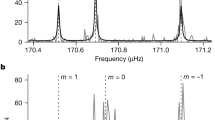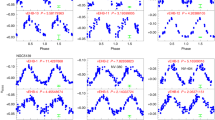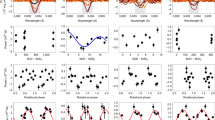Abstract
Magnetic fields play a part in almost all stages of stellar evolution1. Most low-mass stars, including the Sun, show surface fields that are generated by dynamo processes in their convective envelopes2,3. Intermediate-mass stars do not have deep convective envelopes4, although 10 per cent exhibit strong surface fields that are presumed to be residuals from the star formation process5. These stars do have convective cores that might produce internal magnetic fields6, and these fields might survive into later stages of stellar evolution, but information has been limited by our inability to measure the fields below the stellar surface7. Here we report the strength of dipolar oscillation modes for a sample of 3,600 red giant stars. About 20 per cent of our sample show mode suppression, by strong magnetic fields in the cores8, but this fraction is a strong function of mass. Strong core fields occur only in red giants heavier than 1.1 solar masses, and the occurrence rate is at least 50 per cent for intermediate-mass stars (1.6–2.0 solar masses), indicating that powerful dynamos were very common in the previously convective cores of these stars.
This is a preview of subscription content, access via your institution
Access options
Subscribe to this journal
Receive 51 print issues and online access
$199.00 per year
only $3.90 per issue
Buy this article
- Purchase on Springer Link
- Instant access to full article PDF
Prices may be subject to local taxes which are calculated during checkout




Similar content being viewed by others
References
Landstreet, J. D. Magnetic fields at the surfaces of stars. Astron. Astrophys. Rev. 4, 35–77 (1992)
Parker, E. N. Hydromagnetic dynamo models. Astrophys. J. 122, 293–314 (1955)
Donati, J.-F. & Landstreet, J. Magnetic fields of nondegenerate stars. Annu. Rev. Astron. Astrophys. 47, 333–370 (2009)
Kippenhahn, R. & Weigert, A. Stellar Structure and Evolution (Springer, 1990)
Power, J., Wade, G. A., Aurière, M., Silvester, J. & Hanes, D. Properties of a volume-limited sample of Ap-stars. Contrib. Astron. Observ. Skalnate Pleso 38, 443–444 (2008)
Brun, A. S., Browning, M. K. & Toomre, J. Simulations of core convection in rotating A-type stars: magnetic dynamo action. Astrophys. J. 629, 461–481 (2005)
Aurière, M. et al. The magnetic fields at the surface of active single G-K giants. Astron. Astrophys. 574, A90 (2015)
Fuller, J., Cantiello, M., Stello, D., Garcia, R. A. & Bildsten, L. Strong internal magnetic fields explain suppressed oscillation modes in red giant stars. Science 350, 423–426 (2015)
De Ridder, J. D. et al. Non-radial oscillation modes with long lifetimes in giant stars. Nature 459, 398–400 (2009)
Stello, D., Bruntt, H., Preston, H. & Buzasi, D. Oscillating K giants with the WIRE satellite: determination of their asteroseismic masses. Astrophys. J. 674, L53–L56 (2008)
García, R. A. & Stello, D. in Extraterrestrial Seismology (eds Tong, V. C. H. & García, R. A. ) Ch. 11 (Cambridge Univ. Press, 2015)
Bedding, T. R. et al. Gravity modes as a way to distinguish between hydrogen- and helium-burning red giant stars. Nature 471, 608–611 (2011)
Stello, D. et al. Asteroseismic classification of stellar populations among 13,000 red giants observed by Kepler. Astrophys. J. 765, L41 (2013)
Mosser, B. et al. Mixed modes in red giants: a window on stellar evolution. Astron. Astrophys. 572, L5 (2014)
Beck, P. G. et al. Kepler detected gravity-mode period spacings in a red giant star. Science 332, 205 (2011)
Mosser, B. et al. Spin down of the core rotation in red giants. Astron. Astrophys. 548, A10 (2012)
Dupret, M.-A. et al. Theoretical amplitudes and lifetimes of non-radial solar-like oscillations in red giants. Astron. Astrophys. 506, 57–67 (2009)
Mosser, B. et al. Characterization of the power excess of solar-like oscillations in red giants with Kepler. Astron. Astrophys. 537, A30 (2012)
García, R. A. et al. Study of KIC 8561221 observed by Kepler: an early red giant showing depressed dipolar modes. Astron. Astrophys. 563, A84 (2014)
Gough, D. O. & McIntyre, M. E. Inevitability of a magnetic field in the Sun’s radiative interior. Nature 394, 755–757 (1998)
Braithwaite, J. & Spruit, H. C. A fossil origin for the magnetic field in A stars and white dwarfs. Nature 431, 819–821 (2004)
Duez, V., Braithwaite, J. & Mathis, S. On the stability of non-force-free magnetic equilibria in stars. Astrophys. J. 724, L34–L38 (2010)
Moss, D. On the magnetic flux distribution in magnetic CP stars. Mon. Not. R. Astron. Soc. 226, 297–307 (1987)
Cantiello, M., Mankovich, C., Bildsten, L., Christensen-Dalsgaard, J. & Paxton, B. Angular momentum transport within evolved low-mass stars. Astrophys. J. 788, 93 (2014)
Busso, M., Wasserburg, G. J., Nollett, K. M. & Calandra, A. Can extra mixing in RGB and AGB stars be attributed to magnetic mechanisms? Astrophys. J. 671, 802–810 (2007)
Nucci, M. C. & Busso, M. Magnetohydrodynamics and deep mixing in evolved stars. I. Two- and three-dimensional analytical models for the asymptotic giant branch. Astrophys. J. 787, 141 (2014)
Salaris, M. & Cassisi, S. Evolution of Stars and Stellar Populations (John Wiley & Sons, 2005)
Miglio, A. et al. Asteroseismology of old open clusters with Kepler: direct estimate of the integrated red giant branch mass-loss in NGC 6791 and 6819. Mon. Not. R. Astron. Soc. 419, 2077–2088 (2012)
Corsaro, E., Ridder, J. D. & Garcia, R. A. Bayesian peak bagging analysis of 19 low-mass low-luminosity red giants observed with Kepler. Astron. Astrophys. 579, A83 (2015)
Huber, D. et al. Asteroseismology of red giants from the first four months of Kepler data: global oscillation parameters for 800 stars. Astrophys. J. 723, 1607–1617 (2010)
Acknowledgements
This paper has been written collaboratively, on the web, using Authorea (http://www.authorea.com). We acknowledge the entire Kepler team, whose efforts made these results possible. D.S. is the recipient of an Australian Research Council Future Fellowship (project number FT140100147). J.F. acknowledges support from NSF under grant number AST-1205732 and through a Lee DuBridge Fellowship at Caltech. R.A.G. acknowledges the support of the European Community’s Seventh Framework Programme (FP7/2007–2013) under grant agreement number 269194 (IRSES/ASK), the CNES, and the ANR-12-BS05-0008, IDEE. D.H. acknowledges support by the Australian Research Council’s Discovery Projects funding scheme (project number DE140101364) and support by the National Aeronautics and Space Administration under grant number NNX14AB92G issued through the Kepler Participating Scientist Program. This project was supported by NASA under TCAN grant number NNX14AB53G, and by the NSF under grant numbers PHY11-25915 and AST11-09174. Funding for the Stellar Astrophysics Centre is provided by The Danish National Research Foundation (grant agreement number DNRF106). The research is supported by the ASTERISK project (ASTERoseismic Investigations with SONG and Kepler) funded by the European Research Council (grant agreement number 267864).
Author information
Authors and Affiliations
Contributions
D.S. measured and interpreted mode visibilities; M.C. and J.F. calculated and interpreted theoretical models; D.H. and D.S. calculated power spectra and measured large frequency separations; R.A.G., T.R.B., L.B. and V.S.A. contributed to the discussion of the results. All authors commented on the manuscript.
Corresponding author
Ethics declarations
Competing interests
The authors declare no competing financial interests.
Source data
Rights and permissions
About this article
Cite this article
Stello, D., Cantiello, M., Fuller, J. et al. A prevalence of dynamo-generated magnetic fields in the cores of intermediate-mass stars. Nature 529, 364–367 (2016). https://doi.org/10.1038/nature16171
Received:
Accepted:
Published:
Issue Date:
DOI: https://doi.org/10.1038/nature16171
This article is cited by
-
Simulations of Solar and Stellar Dynamos and Their Theoretical Interpretation
Space Science Reviews (2023)
-
Magnetic fields of 30 to 100 kG in the cores of red giant stars
Nature (2022)
-
A highly magnetized and rapidly rotating white dwarf as small as the Moon
Nature (2021)
-
HAYDN
Experimental Astronomy (2021)
-
Asteroseismology of solar-type stars
Living Reviews in Solar Physics (2019)
Comments
By submitting a comment you agree to abide by our Terms and Community Guidelines. If you find something abusive or that does not comply with our terms or guidelines please flag it as inappropriate.



